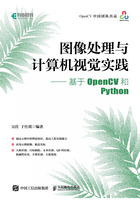
2.1 缩放
缩放是最简单的仿射变换,顾名思义,应用它可将图像放大或缩小。图2-2所示是一幅原始图像,图2-3(a)所示是缩小后的图像,图2-3(b)所示是放大后的图像。

图2-2 原始图像

(a)

(b)
图2-3 图2-2缩放后的图像
将图像放大或缩小后会得到新图像,比如将100×100的图像放大为200×200,如果原始图像有1万个像素点,那么新图像中有4万个像素点,这4万个像素点的值应该怎么根据原始图像的像素值来计算呢?这就需要用到一个重要的技术——插值。
我们先来看一个例子。如图2-4所示,有一幅大小为3×3的图像,将其按长宽等比例放大4/3倍后得到一幅4×4的新图像,新图像中(2, 1)位置的像素对应于原始图像(1.5, 0.75)位置。但是原始图像的像素都位于整数坐标位置,于是新图像在原始图像中的对应点(1.5, 0.75)位置的像素值就需要根据其周围在整数位置的像素值来计算得出,比如可以用图2-4(a)中深色区域的4个像素来计算,这就是插值。
最简单的插值方法就是直接取距离(1.5, 0.75)最近的整数位置像素的值,这种方法叫作最近邻插值。
双线性插值是一种常用的插值方法,它是线性插值的扩展。在数学上,线性插值是一种曲线拟合的方法,它通过线性多项式来计算已知相邻数据点之间的点。如图2-5所示,假设已知 和
和 两点,用线性插值可以计算出这两点间连线上的点,也就是说给出x0和x1间的一个值x,对应的y值可用下面的式(2-1)计算得出:
两点,用线性插值可以计算出这两点间连线上的点,也就是说给出x0和x1间的一个值x,对应的y值可用下面的式(2-1)计算得出:

即

式(2-1)

(a) (b)
图2-4 插值

图2-5 线性插值
对线性插值进行扩展,在两个方向上分别进行一次线性插值,即对x和y都进行插值,这样的方法就称为双线性插值。如图2-6所示,我们需要得到点 的值,假设已知
的值,假设已知 、
、 、
、 和
和 这4个点的值。
这4个点的值。

图2-6 双线性插值
先在x轴方向进行线性插值,得到 和
和 点的值:
点的值:


式(2-2)
然后在y轴方向根据点 和
和 进行线性插值,便得到点P的值:
进行线性插值,便得到点P的值:

式(2-3)
双线性插值的结果与插值顺序无关,先进行x轴方向插值和先进行y轴方向插值的最终结果是一样的。需要注意的是,双线性插值并不是线性的,而是非线性的。对于其他的插值方法,感兴趣的读者可以查阅相关资料进行了解。
OpenCV提供了对图像进行缩放的函数cv.resize(),该函数支持多种插值方法。
dst = cv.resize(src, dsize[, fx[, fy[, interpolation]]])
其中的主要参数介绍如下。
● dst:输出图像,大小为dsize,或由src的大小、fx和fy计算得到。
● src:输入图像。
● dsize:输出图像的大小。如果其为None,则

● fx:图像宽的缩放比例。如果该值为0,则按 计算得出。
计算得出。
● fy:图像高的缩放比例。如果该值为0,则按 计算得出。
计算得出。
● interpolation:插值方法。插值方法和说明如表2-1所示。默认的插值方法是双线性插值INTER_LINEAR。
表2-1 插值方法和说明

不同的插值方法会产生不同质量的图像,同时它们的计算速度也不一样。图2-7中的4幅图为采用不同的插值方法将图2-2放大2倍后的图像,图2-7(a)~图2-7(d)依次为使用最近邻插值、双线性插值、双三次插值和LANCZOS插值得到的新图像。对比结果可以看出,最近邻插值会让图像产生锯齿效果,双线性插值会让图像边缘变模糊,而双三次插值和LANCZOS插值的效果均较好。从速度上看,这4种插值方法中,最近邻插值速度最快,双线性插值的速度较快,双三次插值的速度一般,而LANCZOS插值的速度最慢。

(a)

(b)

(c)

(d)
图2-7 使用不同的插值方法将图2-2放大2倍后的图像
实现代码如下:
import cv2 as cv
import numpy as np
def main():
# 读入图像
im = cv.imread('lena.jpg')
cv.imshow('lena.jpg', im)
# 缩放图像
dim = (int(im.shape[1]*2), int(im.shape[0]*2))
im_rs_nr = cv.resize(im, dim, interpolation=cv.INTER_NEAREST)
im_rs_ln = cv.resize(im, dim, interpolation=cv.INTER_LINEAR)
im_rs_cb = cv.resize(im, dim, interpolation=cv.INTER_CUBIC)
im_rs_lz = cv.resize(im, dim, interpolation=cv.INTER_LANCZOS4)
cv.imshow('lena_rs_nr.jpg', im_rs_nr)
cv.imshow('lena_rs_ln.jpg', im_rs_ln)
cv.imshow('lena_rs_cb.jpg', im_rs_cb)
cv.imshow('lena_rs_lz.jpg', im_rs_lz)
cv.waitKey()
cv.destroyAllWindows()
if __name__ == '__main__':
main()